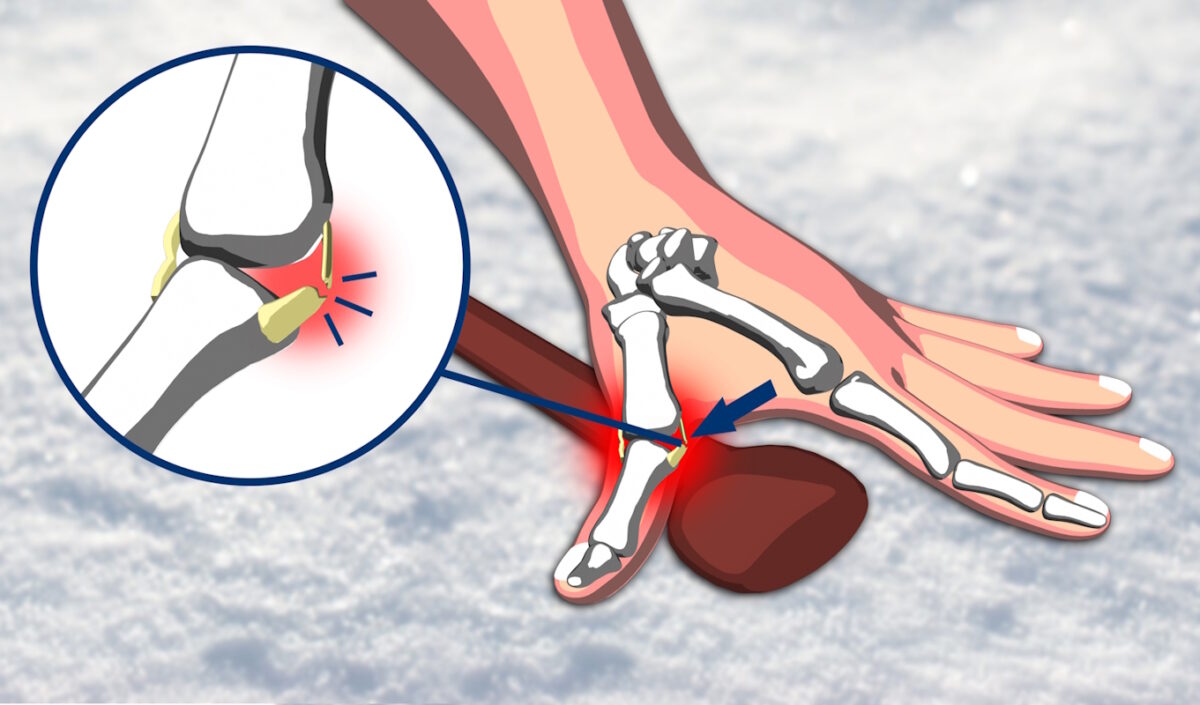Josh* loves to ski. Granted, he hasn’t been doing it for very long and still considers himself a rookie, but he took to it so quickly that even college buddies who had been skiing for significantly longer had to admit he was a natural. Sadly, Josh’s latest trip to the slopes of Colorado ended in a small tragedy when he fell and injured his thumb. At first, he didn’t think much of it and figured he could “power through” the pain. But when a friend noticed how much Josh was wincing and clearly couldn’t properly grip his ski pole, he forced him back to the lodge to take a closer look. Within an instant, his veteran skier friend said he might have skier’s thumb.
While the term “skier’s thumb” may not sound real, it absolutely is. Skier’s thumb is the second most common ski-related injury after knee injury. It impacts roughly 200,000 patients per year in the United States and typically happens when you fall on an outstretched hand and thumb while holding the ski pole. As the palm of your hand hits the ground while still holding the pole, the thumb is stretched to the point where the ligaments can tear.
The condition will get worse if left untreated, limiting your ability to do more than just ski. A doctor—not a fellow friend on the ski slopes—must accurately diagnose your condition. But common symptoms can include:
- Pain at the base of the thumb between the thumb and index finger
- Pain when trying to grasp an item
- Thumb pain that worsens with movement
- Swelling and bruising of the thumb
- Reduced range of motion
- Pain that radiates into the wrist
- General weakness
Even if you received a proper diagnosis for skier’s thumb, it can be confusing knowing what to expect and how to properly treat it so that you can get back to what you enjoy doing. At Fort Worth Hand Center, our mission is to provide the best care possible and educate you on your journey back to being pain-free. No matter the condition, we want to address all your hand and upper extremity questions so that you can make important health decisions.
Why Is It Called Skier’s Thumb?
Skier’s thumb is an injury to the ulnar collateral ligament of the first metacarpophalangeal joint. This combination of joints is important in terms of joint stabilization and proper hand function—specifically, your ability to grip and pinch. It is related to 86% of all injuries to the base of the thumb.

Skier’s thumb isn’t exclusive to skiers. In other words, you could suffer this same exact injury in other ways, such as in a car crash, sports such as hockey, soccer, basketball, and volleyball, or another scenario where the thumb is abnormally bent backward. And yet, it’s more prevalent while skiing, hence the name. Plenty of people—especially athletes and individuals who live active lifestyles—have fallen on their outstretched hand for various reasons. But it’s the combination of the fall while holding the ski pole that generally creates enough force to injure the soft tissue that connects the bones of your thumb. A similar fall with an empty palm typically does not create the same force—though you can still be injured.
In terms of severity, skier’s thumb has several grades.
- Grade I — Minimal stretching that could heal on its own.
- Grade II — More significant stretching or tearing
- Grade III — A complete tear that likely requires surgery.

Can Skier’s Thumb Heal On Its Own?
As mentioned above, it depends on the severity of the injury. Grade I and II skier’s thumb might be treatable by having you wear a thumb splint or cast for six weeks to immobilize and protect the joint. Your doctor may also prescribe non-steroidal anti-inflammatory drugs to help with pain and inflammation. Ice therapy and elevating your hand are also conservative treatment options that can be highly successful in the right situations.
The first step is to, of course, undergo a thorough physical examination with an orthopedic surgeon. Your doctor will manually test the stability and strength of the joint and look for any lesions or bumps that suggest a complete rupture of the UCL joint. They will also take X-rays to examine the joint closely.
If there is a complete rupture, surgery will likely be recommended to restore stability to the thumb. The recommended format for this surgery includes making a small incision along the inner side of the thumb and the back of the thumb and directly suturing the ligament to itself or an adjacent bone. You won’t feel any pain during the procedure, and your hand will be placed in a cast immediately afterward to immobilize the thumb for four weeks. This is typically followed by two weeks of immobilization with a removable splint.
Your doctor will also ask you to undergo physical therapy to increase strength and regain full range of motion in the joint. You will still want to avoid stressing the ligament for three or four months following surgery.

Did You Suffer a Skier’s Thumb Injury? We Can Help!
The good news about skier’s thumb is that it doesn’t have to keep you away from the ski slopes forever. You also aren’t alone. This is a common injury, and regardless of the severity of the injury, conservative and surgical treatments are highly successful.
The first step is to see one of our expert physicians for an accurate diagnosis and treatment options. Waiting or ignoring your injury in hopes that it will heal on its own could work. But the reality is that it likely won’t—leading to long-term pain and other complications that can impact your ability to do the things you love doing. Don’t do this to yourself—call one of our experts today!
From the fingertips to the elbow, Fort Worth Hand Center treats everything from sports injuries and joint replacement to chronic conditions, age-related complications, and trauma. We offer the best and most experienced hand surgeons in Fort Worth. We care about our patients and strive to provide the best care.
To learn more or to schedule an appointment, call 817-877-3277 or complete the form below.



